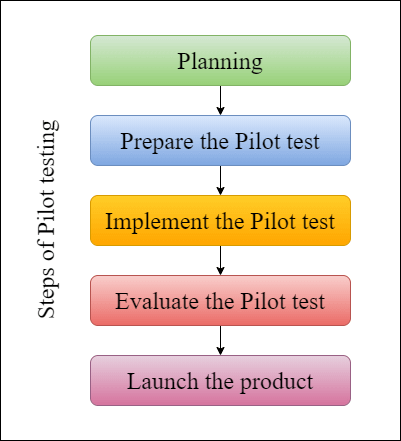Pilot TestingWhat is Pilot Testing?Pilot testing is software testing where a user verifies the software before their final deployment or launch. In other words, it verifies the core functionality of the software before it goes into production. The main purpose this testing is to evaluate the cost, project performance, feasibility, time, and risk. Pilot testing is performed between production and User Acceptance Testing (UAT). In this testing, a user tries to confirm the software under test and provides a feedback report before full deployment of the software. It helps in the quick detection of errors in the software. It relates to installing a system at a user site for regular use. Typically, pilot testing depends on the scope and size of the user system. The most common form of pilot testing is to continuously test the entire software so that its weak areas can be detected. Then, these weaknesses are sent to the team of developers in the form of bug reports so that the developer's team can fix these bugs. How to do Pilot TestingGenerally, pilot testing is done in a dedicated field where the users work on the multiple programs and components of the S/W. 
Steps of Pilot testing
Objectives of Pilot TestingThe following are the objectives of pilot testing:
Why Pilot Testing is ImportantPilot testing is important because it checks the debugging software, process used for testing, and product readiness for full-scale implementation. Examples of Pilot Testing
Difference between Pilot Testing, Beta Testing, and Alpha Testing?Pilot Testing: Pilot testing is S/W testing where a user verifies the software before their final deployment or launch. In other words, it verifies the core functionality of the software before it goes into production. This testing's main purpose is to evaluate the cost, project performance, feasibility, time, and risk. Pilot testing is performed between production and User Acceptance Testing (UAT). Beta Testing: Beta testing is done in real environments by real users of the software. A beta version of the S/W, which requires feedback, is released to a limited number of product users to receive feedback on product quality. Beta testing helps to reduce the risk of product failure, and it provides increased product quality through customer verification. Alpha Testing: Alpha testing is a type of S/W testing that is done to identify bugs before the launch of the product. The alpha test is one of the User Acceptance Test. It is referred to as an alpha test because it is done early, at the end of software development. Alpha testing is usually performed by quality assurance staff. This is the final testing phase before the software is launched to the public.
Requisites for Pilot TestingThe main requisites for performing the Pilot Testing are: 1. Correct group of Testers While conducting this test, the tester team manager has to ensure that there is the right group of testers who represent the target audience. If the tester's right group is not selected for pilot testing, the pilot testing cannot be done successfully. 2. Appropriate Environment Any test process requires a suitable environment. This is a requirement to carry out the test successfully. To do pilot testing, we need a real environment. After that, proper hardware and software have to be introduced. Therefore, the testing process must create the same conditions that end-users must face. 3. Adequate Planning Planning for any testing or development is necessary. While conducting pilot testing, it is necessary to ensure that all resources are in the correct measurements. Advantages of Pilot Testing
Next TopicSweetAlert
|
 For Videos Join Our Youtube Channel: Join Now
For Videos Join Our Youtube Channel: Join Now
Feedback
- Send your Feedback to [email protected]
Help Others, Please Share









